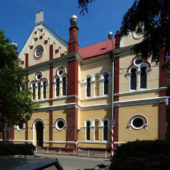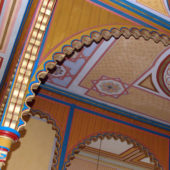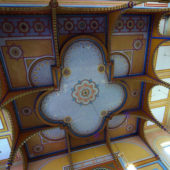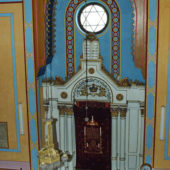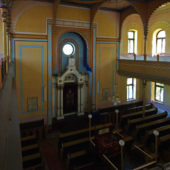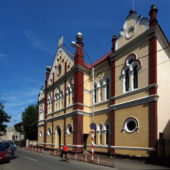Located only a few blocks from Elie Wiesel’s childhood home, this synagogue serves a community of about 120 Jews. Sighet’s Jewish population before the Holocaust was more than 20,000.
The first record of Jews in the Transylvania region of Romania was in Saxon citadels in 1492. Through the centuries there was significant persecution of Jews in Romania, but much less in Transylvania. In 1623 Prince Gabriel Bethlen granted the Jewish people privileges, with the aim to attract entrepreneurs from the Ottoman lands into Romania; however, these privileges were rescinded in the following decades, when it was decided that the Jews were only allowed to settle in Gyulafehervar. Jews were allowed to wear traditional Jewish clothing, and it was permissible for the clothing to reflect the wearer’s economic status (1650 and 1741).
From 1765 through 1774, the country was plunged into the Russo-Turkish Wars, and Jews all over the country suffered great hardships. Massacres and pillages took place in nearly every town and village throughout Romania. When peace was restored, both princes, Alexander Mavrocordatos of Moldavia and Nicholas Mavroghenia of Wallachia, pledged their protection to the Jewish people. Conditions for Jewish people remained favorable until 1787, when the Janissaries and the Russian Army partook in pogroms (destruction, slaughter, devastation, butchery against the Jewish people). They also began to be persecuted by their neighbors and Jewish children were seized and forcibly baptized. There were ritual-murder accusations which became widespread; the worst was at Galati in 1797 when a large mob attacked Jews, taking them from their homes, robbed them, waylaid them on the streets murdering many. Some Jews were taken to the Danube and drowned, others ran to the synagogue for refuge, but it was set on fire and they were burnt to death. Few escaped, having been provided assistance and refuge by a priest.
In Transylvania, due to the reforms set forth by Joseph II, Jews were allowed to settle peacefully in towns subject to the Hungarian Crown. However, pressure placed on the community, due to the anti-Semitism of the rest of the country, remained stringent for decades. The Jewish community set up 32 guilds, one for each type of profession, which handled the collection of taxes in proportion to the number of people it organized. In 1821 Romania revolted against its Ottoman rulers and again in 1848, against its Russian governors. Some Jews took place in this last revolt; however, the Russians quickly quashed it. In 1866, a constitution was written that read, “Only such aliens as are of the Christian faith may obtain citizenship.” This was a time of significant anti-Semitism. As many Jews tried to cross the Danube to settle into the Ottoman Empire, they would be refused and drowned in the river.
In 1872, under the direction of the first American diplomat in Romania, the first general Jewish representative body, after the dissolution of the Jewish Guild, was the Brotherhood of Zion Society. The forerunner of B’nai B’rith, it comprised the Jewish leaders at the time. They discussed the problems and did not see any resolution, other than emigration. In spite of these horrors, Yiddish theater was born. Abraham Goldfaden founded the first professional Yiddish theater company in Lasi in 1876. More than 100 years later, in 2006, there was still an active Yiddish theater in Bucharest.
The Russo-Turkish War was concluded with the Treaty of Berlin in 1878. The result for the Jews was that non-Christians (Muslims and Jews) would receive full-citizenship in the newly acquired region of Northern Dobruja. An argument arose about this clause, and it was amended to state that the protection of every individual’s case would be decided under parliament.
From 1830 to 1880, Sighet grew from a small village to an important regional center, and the Jewish community similarly flourished. By 1880 there were over 3,650 Jews in the city, growing to over 4,000 in the next 30 years. Yet they were somewhat limited in the professions they were allowed undertake. In 1893, legislation was passed excluding Jewish children from public schools, unless the parents paid tuition. That same year, Jewish youths were excluded from public secondary schools and universities. Approximately 70,000 Jews emigrated from Romania between 1898 and 1904.
The Anti-Confederation (Neo-Nazi group) moved to exclude Jews from all professional associations. The threat posed by the Iron Guard was looming. However, playboy King Carol II, who reigned as King of Romania from 1930 to 1940, ineffectively tried to fight against the anti-Semitic Iron Guard (far-right anti-Semitic political party), had a Jewish lover and many of his friends were Jewish. Much as he tried to help the Jewish people, he was no match for the Nazi and Fascist powers. By 1942, eighty anti-Jewish conditions were established. Jews were tortured and beaten and their shops looted.
During WWII, Romania was divided into two parts; Sighet was taken over by the Hungarians. From July to August 1941, many Jews were forced to wear the yellow arm badge. The Wiesel Commission states that Romania murdered between 280,000 to 380,000 Romanian Jews, while many in Romania deny knowledge that their country participated in the Holocaust. Many were forced to be part of the “trains of death” (long, exhausting marches on foot) to the East. Others were sent to concentration camps where few survived. During the two decades Following the Holocaust over 200,000 surviving Romanian Jews immigrated to Israel. Today, only 9,000 to 15,000 Jews live in Romania. As a comparison, in 1924, there were 796,056 Jews in Romania, and 193,000 in Transylvania alone.
Sighet was at one time 70% Jewish, ruled by two Jewish clans, the Teitelbaums and the Kahans. The Kahan Synagogue is Orthodox, as are most synagogues in small towns in Romania. At one time there were six synagogues and many prayer houses in Sighet. Now there is only the Kahan Synagogue. The Sighet Jewish community numbers only about 120 today. Sighet is best known today as the hometown of Elie Wiesel.
The exterior of the synagogue is neo-Gothic, faux-Italianate. The façade is peach with striking terracotta brickwork, white molding, and red tile roofing, which is in need of some repair. Inside, the interior of the prayer room is fantastical example of faux-Italianate design. The background color of the walls and ceiling is yellow, with the hand-painted designs created in blue, white and red. Intricately carved woodwork adorn the archways tapering down to slim columns supporting the women’s galleries along the sides and back of the sanctuary. The walls and the ceiling are beautifully decorated and there is a specially carved and hand-painted inset in the front wall, where the Aron Kodesh is placed. The Aron Kodesh is majestic in white, with several columns on each side with gilded and royal blue Corinthian capitals, supporting a classical head in white with accents of gold and royal blue. Perched on the top are the twin tablets etched in Hebrew with The Ten Commandments. A burgundy velvet Torah curtain with gold embroidery is drawn across the front. The Aron Kodesh is offset by the round window behind it featuring the Star-of-David and the beautiful Italianate hand-painting in blues, red, gold, yellow and pink. In the center of the prayer-room is the tivah (reader’s desk), simply carved in wood, draped with a burgundy throw and surrounded in the front and back by wood panels. Two stories of windows adorn the right side, front and back of the prayer room. The sanctuary is filled with simply carved wood pews.

